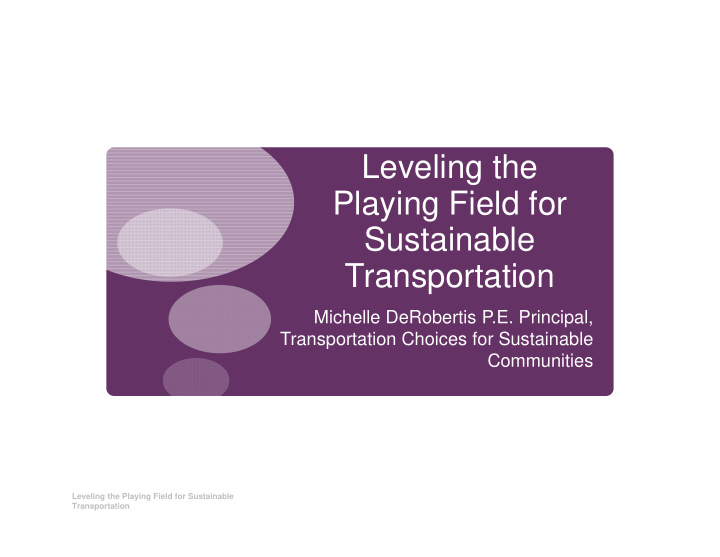



Leveling the Playing Field for Sustainable Transportation Michelle DeRobertis P.E. Principal, Transportation Choices for Sustainable Communities Leveling the Playing Field for Sustainable Transportation
Sources: “ Changing the Paradigm of Traffic Impact Studies: How Typical Traffic Studies Inhibit Sustainable Transportation ”, May 2014 ITE Journal 2014 Transportation Studies in the 21 st Century: Accommodating all Modes, panel at the 2014 ProWalk ProBike ProPlace conference ITE Transit Council Committee:“Transit and Traffic Impact Studies” Leveling the Playing Field for Sustainable Transportation
Why we need CHOICES… C - Congestion H - Health O- Others I - Impacts C- Costs E- Efficiency S - Safety Slide 3
It’s All About Choices Unhealthy Food Choices Unhealthy Transportation Choices Leveling the Playing Field for Sustainable Transportation
Consequences Effects of an Unbalanced Diet Effects of an Unbalanced Transportation System coronary heart disease Auto Congestion high blood pressure Air Pollution obesity Climate change/GHG tooth decay 20 % fatality rate for pedestrians diabetes And all the problems to the left as well Leveling the Playing Field for Sustainable Transportation
Status Quo: Singular Focus on Maintaining Auto LOS D
Unintended Consequences: 1. Inequitable Development Conditions First in pays least Last in pays most (or changes project)
2. SPRAWL
3. Huge wide swaths of asphalt unused for 22 hours a day
Focus on 2 hour period- LOS Measure Here
4. Double Standard
Problem: only measure one thing, only improve that thing Undue attention is given to the LOS of the surrounding freeways and arterials Very little attention to the Transit Service - Report may mention the number and frequency of busses, but does not rate whether the existing transit service is “good” or “adequate” Conclusion often is that Roadways are operating at LOS F and “need improving” whereas the Transit service just “is”.
Result of Lopsided Analysis NO CHANGES TO MORE CAPACITY FOR AUTO TRANSIT, BICYCLE OR PEDESTRIAN INFRASTRUCTURE
21 Century Setting- Social Landscape is Changing Fewer miles driven
Fewer Teen Drivers 1983- 2010 90 80 70 60 50 40 1983 2010 30 20 10 0 16 17 18 16 17 18 19 19
21 st Century Setting-: CAR FREE Households Are Increasing
Even State Laws Are Changing Many States now have GHG reduction targets SB 743 in California -prohibits vehicle congestion from being considered significant impact in Environmental Documents
Many Metrics but all still only measure AUTO Travel Roadway volume-to-capacity (v/c) Auto delay at Intersection Corridor travel time Vehicle miles of travel
you FIX WHAT YOU MEASURE… IS WHAT YOU GET/ FIX YOU FIX
Purpose of ITE Committee on Transit & Traffic Impact Studies Document whether and how: STATE OF THE PRACTICE Transit Quality of Service is addressed. Traffic impacts on transit RECOMMENDED PRACTICE service and operations is addressed. BETTER TRANSIT Transit providers are involved SERVICE in the TIS process.
State of the Practice Study Methodology Survey practitioners on the state of the STATE OF THE PRACTICE practice on Transit and Traffic Impact Studies. Review of known traffic impact studies and TIS guidelines to see how well they RECOMMENDED PRACTICE address transit. Write a “State of the Practice” report to be published by ITE. Phase 2 will be to develop an ITE BETTER TRANSIT SERVICE Recommended Practice
How to Level the Playing Field Between Modes?? 1. Need to analyze transit, bikes and peds at the same level of scrutiny as for autos. 2. Impact of auto traffic on other modes should be analyzed not vice versa. 3. Include ways to improve mobility of transit users, cyclists and pedestrians Leveling the Playing Field for Sustainable Transportation
Current Transit QOS Measurements* SERVICE AVAILABILITY Spatial- where the routes are Temporal – hours of service, headways Capacity- [function of vehicle size and headways] (1) COMFORT AND CONVENIENCE Passenger load Average Speed -Travel Time (2) Reliability Safety and security Stations and stops *Source: Transit Capacity and Quality of Service Manual 3 rd Edition, TRB
Possible Metrics for use in Traffic Studies 1. Capacity compare capacity of traffic lanes serving a site to the capacity of transit service in same corridor Mitigation measures to improve capacity: Decrease headways more/larger train cars
SAN FRANCISCO MUNI – Frequency standards Weekday PEAK BASE EVENING OWL RADIAL 10 15 20 30 EXPRESS 10 - - - CROSS- 15 15 20 30 TOWN FEEDER 20 30 30 -- Source: SF Congestion Management Program, SFCTA, 2013
Possible Metrics for use in Traffic Studies 2. Travel time- Compare transit travel time to the site to the auto- travel time. Mitigation measures to improve travel time Transit signal preemption Bus only lanes
SAN FRANCISCO CMP – Travel Time Comparison Source: SF Congestion Management Program, Appendix 6, SFCTA, 2013
21st Century Way of Thinking: 1. System is not “failing” when there is auto congestion. 2. Congestion indicates that more & better public transit is needed as well as more & better bikeways/walkways. 3. Studies must measure transit, bike and pedestrians as seriously as automobiles. 4. We can start by assessing – with the aim of improving – transit travel times and capacity to project sites.
Conclusions Leveling the Playing Field for Sustainable Corso Inghilterra Turin Italy Transportation
Recommend
More recommend